

Compact Muon Solenoid
LHC, CERN
| CMS-HIG-19-014 ; CERN-EP-2022-019 | ||
| Search for Higgs boson decays to a Z boson and a photon in proton-proton collisions at $\sqrt{s} = $ 13 TeV | ||
| CMS Collaboration | ||
| 27 April 2022 | ||
| JHEP 05 (2023) 233 | ||
| Abstract: Results are presented from a search for the Higgs boson decay H $\to$ Z$\gamma$, where Z $\to \ell^{+}\ell^{-}$ with ${\ell} =$ e or $\mu$. The search is performed using a sample of proton-proton (pp) collision data at a center-of-mass energy of 13 TeV, recorded by the CMS experiment at the LHC, corresponding to an integrated luminosity of 138 fb$^{-1}$. Events are assigned to mutually exclusive categories, which exploit differences in both event topology and kinematics of distinct Higgs production mechanisms to enhance signal sensitivity. The signal strength $\mu$, defined as the product of the cross section and the branching fraction [${{\sigma(pp\to\mathrm{H})} {\mathcal{B}(\mathrm{H \to Z\gamma})} } $] relative to the standard model prediction, is extracted from a simultaneous fit to the ${{\ell^{+}\ell^{-}} \gamma}$ invariant mass distributions in all categories and is found to be $\mu=$ 2.4 $\pm$ 0.9 for a Higgs boson mass of 125.38 GeV. The statistical significance of the observed excess of events is 2.7 standard deviations. This measurement corresponds to ${{\sigma(pp\to\mathrm{H})} {\mathcal{B}(\mathrm{H \to Z\gamma})} } =$ 0.21 $\pm$ 0.08 pb. The observed (expected) upper limit at 95% confidence level on $\mu$ is 4.1 (1.8). The ratio of branching fractions ${{\mathcal{B}(\mathrm{H \to Z\gamma})} /{\mathcal{B}({\mathrm{H}\to\gamma\gamma} )} }$ is measured to be 1.5$^{+0.7}_{-0.6}$, which agrees with the standard model prediction of 0.69 $\pm$ 0.04 at the 1.5 standard deviation level. | ||
| Links: e-print arXiv:2204.12945 [hep-ex] (PDF) ; CDS record ; inSPIRE record ; HepData record ; Physics Briefing ; CADI line (restricted) ; | ||
| Figures | |

png pdf |
Figure 1:
Feynman diagrams for H $\to$ Z$\gamma$ decay. |
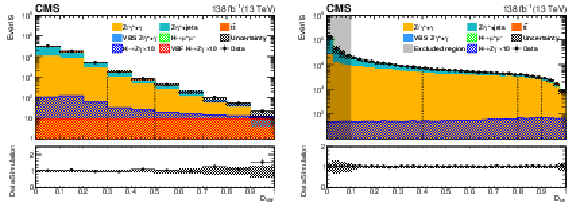
png pdf |
Figure 2:
The ${\mathcal {D}_{\text {VBF}}}$ (left) and ${\mathcal {D_{\text {kin}}}}$ (right) distributions for signal, simulated background, and data. The ${\mathcal {D}_{\text {VBF}}}$ distribution includes only dijet-tagged events, and the ${\mathcal {D_{\text {kin}}}}$ distribution includes only untagged events. The sum of contributions from all signal production mechanisms is shown by the blue line, while the contribution from only the VBF mechanism is shown by the red line. Both contributions are scaled by a factor of 10. The uncertainty band incorporates all statistical and systematic uncertainties in the expected background. The dashed lines indicate the boundaries for the dijet and untagged categories. The gray shaded region in the ${\mathcal {D_{\text {kin}}}}$ distribution is excluded from the analysis. |

png pdf |
Figure 2-a:
The ${\mathcal {D}_{\text {VBF}}}$ ${\mathcal {D_{\text {kin}}}}$ distribution for signal, simulated background, and data. |

png pdf |
Figure 2-b:
The ${\mathcal {D}_{\text {VBF}}}$ ${\mathcal {D_{\text {kin}}}}$ distribution for signal, simulated background, and data. The distribution includes only untagged events. The sum of contributions from all signal production mechanisms is shown by the blue line, scaled by a factor of 10. The uncertainty band incorporates all statistical and systematic uncertainties in the expected background. The dashed lines indicate the boundaries for the dijet and untagged categories. The gray shaded region is excluded from the analysis. |

png pdf |
Figure 3:
Fits to the ${m_{{{\ell^{+} \ell^{-}} \gamma}}}$ data distribution in the lepton-tagged (upper left), dijet 1 (upper right), dijet 2 (lower left), and dijet 3 (lower right) categories. In the upper panel, the red solid line shows the result of a signal-plus-background fit to the given category. The red dashed line shows the background component of the fit. The green and yellow bands represent the 68 and 95% CL uncertainties in the fit. Also plotted is the expected SM signal, scaled by a factor of 10. In the lower panel, the data minus the background component of the fit is shown. |
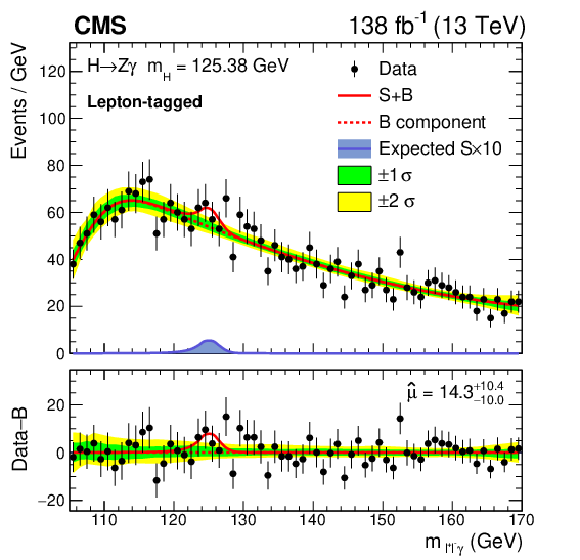
png pdf |
Figure 3-a:
Fits to the ${m_{{{\ell^{+} \ell^{-}} \gamma}}}$ data distribution in the lepton-tagged category. In the upper panel, the red solid line shows the result of a signal-plus-background fit to the given category. The red dashed line shows the background component of the fit. The green and yellow bands represent the 68 and 95% CL uncertainties in the fit. Also plotted is the expected SM signal, scaled by a factor of 10. In the lower panel, the data minus the background component of the fit is shown. |
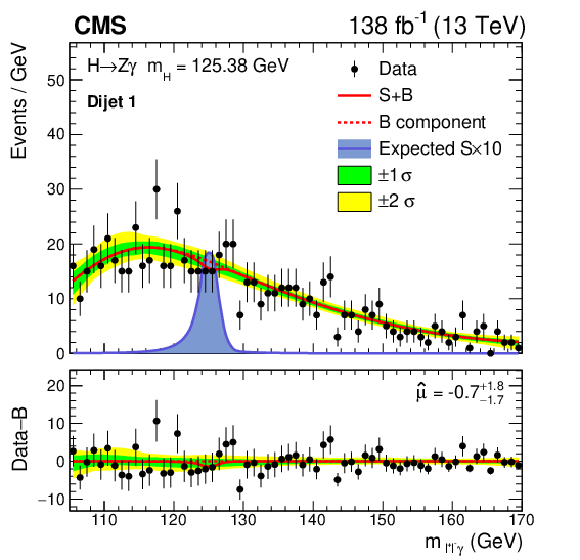
png pdf |
Figure 3-b:
Fits to the ${m_{{{\ell^{+} \ell^{-}} \gamma}}}$ data distribution in the dijet 1 category. In the upper panel, the red solid line shows the result of a signal-plus-background fit to the given category. The red dashed line shows the background component of the fit. The green and yellow bands represent the 68 and 95% CL uncertainties in the fit. Also plotted is the expected SM signal, scaled by a factor of 10. In the lower panel, the data minus the background component of the fit is shown. |
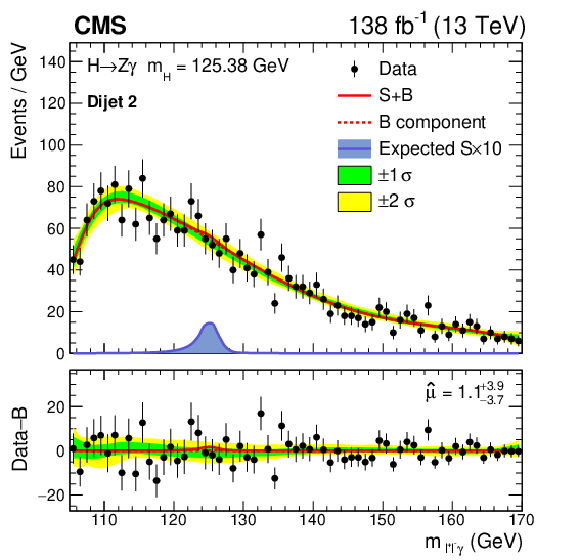
png pdf |
Figure 3-c:
Fits to the ${m_{{{\ell^{+} \ell^{-}} \gamma}}}$ data distribution in the dijet 2 category. In the upper panel, the red solid line shows the result of a signal-plus-background fit to the given category. The red dashed line shows the background component of the fit. The green and yellow bands represent the 68 and 95% CL uncertainties in the fit. Also plotted is the expected SM signal, scaled by a factor of 10. In the lower panel, the data minus the background component of the fit is shown. |

png pdf |
Figure 3-d:
Fits to the ${m_{{{\ell^{+} \ell^{-}} \gamma}}}$ data distribution in the dijet 3 category. In the upper panel, the red solid line shows the result of a signal-plus-background fit to the given category. The red dashed line shows the background component of the fit. The green and yellow bands represent the 68 and 95% CL uncertainties in the fit. Also plotted is the expected SM signal, scaled by a factor of 10. In the lower panel, the data minus the background component of the fit is shown. |
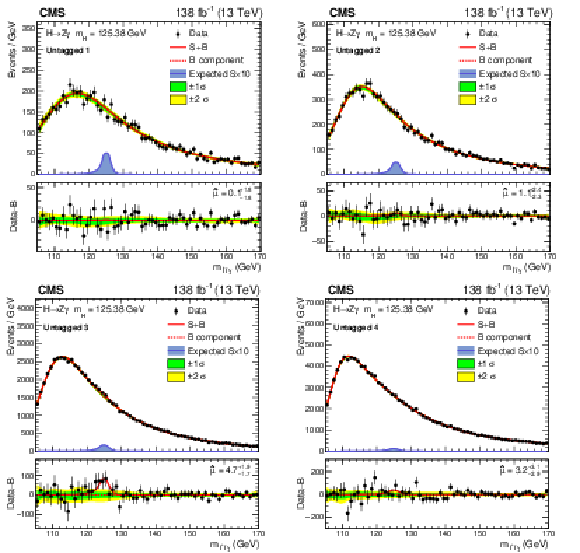
png pdf |
Figure 4:
Fits to the ${m_{{{\ell^{+} \ell^{-}} \gamma}}}$ data distribution in the untagged 1 (upper left), untagged 2 (upper right), untagged 3 (lower left), and untagged 4 (lower right) categories. In the upper panel, the red solid line shows the result of a signal-plus-background fit to the given category. The red dashed line shows the background component of the fit. The green and yellow bands represent the 68 and 95% CL uncertainties in the fit. Also plotted is the expected SM signal, scaled by a factor of 10. In the lower panel, the data minus the background component of the fit is shown. |
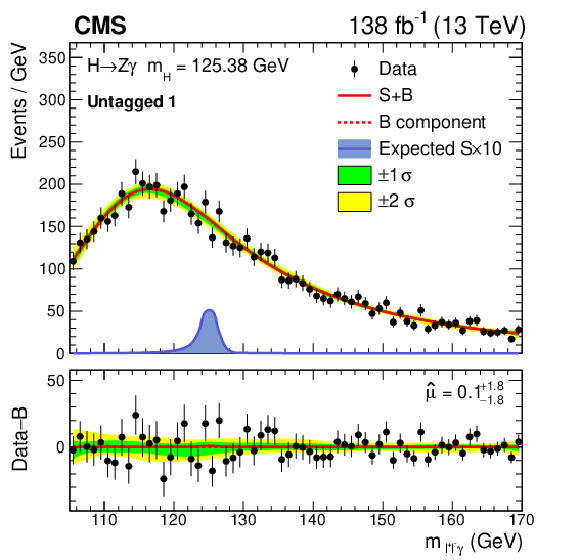
png pdf |
Figure 4-a:
Fits to the ${m_{{{\ell^{+} \ell^{-}} \gamma}}}$ data distribution in the untagged 1 category. In the upper panel, the red solid line shows the result of a signal-plus-background fit to the given category. The red dashed line shows the background component of the fit. The green and yellow bands represent the 68 and 95% CL uncertainties in the fit. Also plotted is the expected SM signal, scaled by a factor of 10. In the lower panel, the data minus the background component of the fit is shown. |

png pdf |
Figure 4-b:
Fits to the ${m_{{{\ell^{+} \ell^{-}} \gamma}}}$ data distribution in the untagged 2 category. In the upper panel, the red solid line shows the result of a signal-plus-background fit to the given category. The red dashed line shows the background component of the fit. The green and yellow bands represent the 68 and 95% CL uncertainties in the fit. Also plotted is the expected SM signal, scaled by a factor of 10. In the lower panel, the data minus the background component of the fit is shown. |
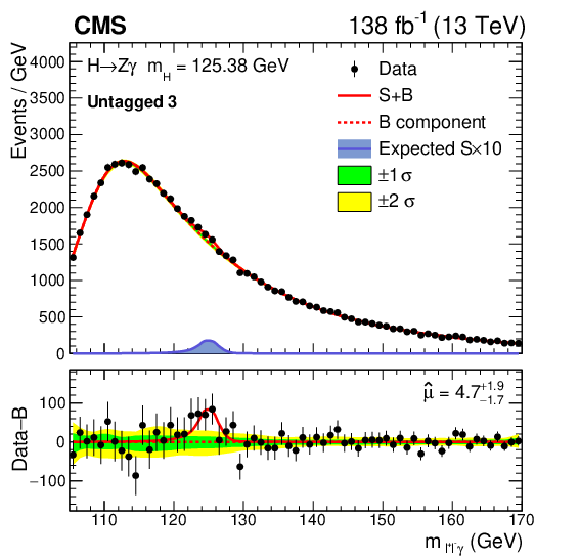
png pdf |
Figure 4-c:
Fits to the ${m_{{{\ell^{+} \ell^{-}} \gamma}}}$ data distribution in the untagged 3 category. In the upper panel, the red solid line shows the result of a signal-plus-background fit to the given category. The red dashed line shows the background component of the fit. The green and yellow bands represent the 68 and 95% CL uncertainties in the fit. Also plotted is the expected SM signal, scaled by a factor of 10. In the lower panel, the data minus the background component of the fit is shown. |

png pdf |
Figure 4-d:
Fits to the ${m_{{{\ell^{+} \ell^{-}} \gamma}}}$ data distribution in the untagged 4 category. In the upper panel, the red solid line shows the result of a signal-plus-background fit to the given category. The red dashed line shows the background component of the fit. The green and yellow bands represent the 68 and 95% CL uncertainties in the fit. Also plotted is the expected SM signal, scaled by a factor of 10. In the lower panel, the data minus the background component of the fit is shown. |

png pdf |
Figure 5:
Sum over all categories of the data points and signal-plus-background model after the simultaneous fit to each ${m_{{{\ell^{+} \ell^{-}} \gamma}}}$ distribution. The contribution from each category is weighted by $S/(S+B)$, as defined in the text. In the upper panel, the red solid line shows the signal-plus-background fit. The red dashed line shows the background component of the fit. The green and yellow bands represent the 68 and 95% CL uncertainties in the fit. Also plotted is the expected SM signal weighted by $S/(S+B)$ and scaled by a factor of 10. In the lower panel, the data minus the background component of the fit is shown. |

png pdf |
Figure 6:
Observed signal strength ($\mu $) for an SM Higgs boson with $ {m_{\mathrm{H}}} = $ 125.38 GeV. The labels "untagged combined," "dijet combined," and "combined" represent the results obtained from simultaneous fits of the untagged categories, dijet categories, and full set of categories, respectively. The black solid line shows $\mu =$ 1, and the red dashed line shows the best fit value $\hat{\mu}= $ 2.4 $\pm$ 0.9 of all categories combined. The category compatibility $p$-value, described in the text, is 0.02, corresponding to 2.3 standard deviations. |

png pdf |
Figure 7:
Upper limit (95% CL) on the signal strength ($\mu $) relative to the SM prediction, as a function of the assumed value of the Higgs boson mass used in the fit. |
| Tables | |

png pdf |
Table 1:
Summary of the category definitions. The lepton-tagged category requires at least one additional electron or muon. Dijet categories are defined by regions of ${\mathcal {D}_{\text {VBF}}}$ and untagged categories are defined by regions of ${\mathcal {D_{\text {kin}}}}$. |

png pdf |
Table 2:
Yields and approximate significance ($S/\sqrt {B}$) for each category, where $S$ and $B$ are the expected number of signal and background events in the narrowest ${m_{{{\ell^{+} \ell^{-}} \gamma}}}$ interval containing 95% of the expected signal distribution. Also shown is the ${m_{{{\ell^{+} \ell^{-}} \gamma}}}$ resolution, computed using the narrowest interval containing 68% of the expected signal distribution. |

png pdf |
Table 3:
Sources of systematic uncertainty affecting the simulated signal. The normalization effect on the expected yield, or the effect on the signal shape parameters, is given as indicated, with the values averaged over all event categories. The third column shows the uncertainties that have a correlated effect across the three data-taking periods. |
| Summary |
| A search is performed for a standard model (SM) Higgs boson decaying into a lepton pair (${\mathrm{e^{+}}\mathrm{e^{-}}}$ or ${\mu^{+}\mu^{-}} $) and a photon with ${m_{{\ell^{+}\ell^{-}} }} > $ 50 GeV. The analysis is performed using a sample of proton-proton (pp) collision data at $\sqrt{s} = $ 13 TeV, corresponding to an integrated luminosity of 138 fb$^{-1}$. The main contribution to this final state is from Higgs boson decays to a Z boson and a photon ($\mathrm{H \to Z\gamma}\to{{\ell^{+}\ell^{-}} \gamma} $). The best fit value of the signal strength $\hat{\mu}$ for ${m_{\mathrm{H}}} =$ 125.38 GeV is $\hat{\mu}=$ 2.4$^{+0.8}_{-0.9}$ (stat) $^{+0.3}_{-0.2}$ (syst) $=$ 2.4 $\pm$ 0.9. This measurement corresponds to ${{\sigma(pp\to\mathrm{H})} {\mathcal{B}(\mathrm{H \to Z\gamma})} } =$ 0.21 $\pm$ 0.08 pb. The measured value is 1.6 standard deviations higher than the SM prediction. The observed (expected) local significance is 2.7 (1.2) standard deviations, where the expected significance is determined for the SM hypothesis. The observed (expected) upper limit at 95% confidence level on $\mu$ is 4.1 (1.8). In addition, a combined fit with the ${\mathrm{H}\to\gamma\gamma}$ analysis of the same data set [18] is performed to measure the ratio ${{\mathcal{B}(\mathrm{H \to Z\gamma})} /{\mathcal{B}({\mathrm{H}\to\gamma\gamma} )} } =$ 1.5$^{+0.7}_{-0.6} $, which is consistent with the ratio of 0.69 $\pm$ 0.04 predicted by the SM at the 1.5 standard deviation level. |
| References | ||||
| 1 | ATLAS Collaboration | Observation of a new particle in the search for the standard model Higgs boson with the ATLAS detector at the LHC | PLB 716 (2012) 1 | 1207.7214 |
| 2 | CMS Collaboration | Observation of a new boson at a mass of 125 GeV with the CMS experiment at the LHC | PLB 716 (2012) 30 | CMS-HIG-12-028 1207.7235 |
| 3 | CMS Collaboration | Observation of a new boson with mass near 125 GeV in pp collisions at $ \sqrt{s} $ = 7 and 8 TeV | JHEP 06 (2013) 081 | CMS-HIG-12-036 1303.4571 |
| 4 | Particle Data Group, P. A. Zyla et al. | Review of particle physics | Prog. Theor. Exp. Phys. 2020 (2020) 083C01 | |
| 5 | A. Abbasabadi, D. Bowser-Chao, D. A. Dicus, and W. W. Repko | Radiative Higgs boson decays $ \mathrm{H}\to f\bar{f}\gamma $ | PRD 55 (1997) 5647 | hep-ph/9611209 |
| 6 | L. B. Chen, C. F. Qiao, and R. L. Zhu | Reconstructing the 125 GeV SM Higgs boson through $ \ell\bar{\ell}\gamma $ | PLB 726 (2013) 306 | 1211.6058 |
| 7 | Y. Sun, H. Chang, and D. Gao | Higgs decays to $ \gamma \ell^+\ell^- $ in the standard model | JHEP 05 (2013) 061 | 1303.2230 |
| 8 | G. Passarino | Higgs boson production and decay: Dalitz sector | PLB 727 (2013) 424 | 1308.0422 |
| 9 | J. M. Campbell, R. K. Ellis, W. T. Giele, and C. Williams | Finding the Higgs boson in decays to Z$\gamma$ using the matrix element method at next-to-leading order | PRD 87 (2013) 073005 | 1301.7086 |
| 10 | G. Degrassi and M. Vitti | The effect of an anomalous Higgs trilinear self-coupling on the $ \mathrm{h}\to\gamma\mathrm{Z} $ decay | EPJC 80 (2020) 307 | 1912.06429 |
| 11 | I. Low, J. Lykken, and G. Shaughnessy | Singlet scalars as Higgs imposters at the Large Hadron Collider | PRD 84 (2011) 035027 | 1105.4587 |
| 12 | L. T. Hue et al. | General one-loop formulas for decay $ \mathrm{h}\to\mathrm{Z}\gamma $ | EPJC 78 (2018) 885 | 1712.05234 |
| 13 | A. Dedes, K. Suxho, and L. Trifyllis | The decay $ \mathrm{h}\to\mathrm{Z}\gamma $ in the standard-model effective field theory | JHEP 06 (2019) 115 | 1903.12046 |
| 14 | A. Hammad, S. Khalil, and S. Moretti | Higgs boson decays into $ \gamma\gamma $ and Z$\gamma$ in the MSSM and the B-L supersymmetric SM | PRD 92 (2015) 095008 | 1503.05408 |
| 15 | C.-X. Liu et al. | Higgs boson decay $ \mathrm{h}\to\mathrm{Z}\gamma $ and muon magnetic dipole moment in the $ \mu\nu $SSM | JHEP 04 (2020) 002 | 2002.04370 |
| 16 | CMS Collaboration | A measurement of the Higgs boson mass in the diphoton decay channel | PLB 805 (2020) 135425 | CMS-HIG-19-004 2002.06398 |
| 17 | LHC Higgs Cross Section Working Group | Handbook of LHC Higgs cross sections: 4. Deciphering the nature of the Higgs sector | CERN Report CERN-2017-002-M, 2016 link |
1610.07922 |
| 18 | CMS Collaboration | Measurements of Higgs boson production cross sections and couplings in the diphoton decay channel at $ \sqrt{s} = $ 13 TeV | JHEP 07 (2021) 027 | CMS-HIG-19-015 2103.06956 |
| 19 | A. Djouadi, V. Driesen, W. Hollik, and A. Kraft | The Higgs-photon-Z boson coupling revisited | EPJC 1 (1998) 163 | hep-ph/9701342 |
| 20 | C.-W. Chiang and K. Yagyu | Higgs boson decays to $ \gamma\gamma $ and Z$\gamma$ in models with Higgs extensions | PRD 87 (2013) 033003 | 1207.1065 |
| 21 | M. Carena, I. Low, and C. E. M. Wagner | Implications of a modified Higgs to diphoton decay width | JHEP 08 (2012) 060 | 1206.1082 |
| 22 | C.-S. Chen, C.-Q. Geng, D. Huang, and L.-H. Tsai | New scalar contributions to $ \mathrm{h}\to\mathrm{Z}\gamma $ | PRD 87 (2013) 075019 | 1301.4694 |
| 23 | H. T. Hung et al. | Neutral Higgs decays $ \mathrm{H} \to \mathrm{Z} \gamma,\gamma\gamma $ in 3-3-1 models | PRD 100 (2019) 075014 | 1907.06735 |
| 24 | P. Archer-Smith, D. Stolarski, and R. Vega-Morales | On new physics contributions to the Higgs decay to Z$\gamma$ | JHEP 10 (2021) 247 | 2012.01440 |
| 25 | ATLAS Collaboration | Search for Higgs boson decays to a photon and a Z boson in pp collisions at $ \sqrt{s} $ = 7 and 8 TeV with the ATLAS detector | PLB 732 (2014) 8 | 1402.3051 |
| 26 | CMS Collaboration | Search for a Higgs boson decaying into a Z and a photon in pp collisions at $ \sqrt{s} = $ 7 and 8 TeV | PLB 726 (2013) 587 | CMS-HIG-13-006 1307.5515 |
| 27 | CMS Collaboration | Search for the decay of a Higgs boson in the $ \ell\ell\gamma $ channel in proton-proton collisions at $ \sqrt{s} = $ 13 TeV | JHEP 11 (2018) 152 | CMS-HIG-17-007 1806.05996 |
| 28 | ATLAS Collaboration | A search for the Z$\gamma$ decay mode of the Higgs boson in pp collisions at $ \sqrt{s} = $ 13 TeV with the ATLAS detector | PLB 809 (2020) 135754 | 2005.05382 |
| 29 | ATLAS Collaboration | Evidence for Higgs boson decays to a low-mass dilepton system and a photon in pp collisions at $ \sqrt{s}= $ 13 TeV with the atlas detector | PLB 819 (2021) 136412 | 2103.10322 |
| 30 | CMS Collaboration | Search for a Higgs boson decaying into $ \gamma^{\ast} \gamma \to \ell \ell \gamma $ with low dilepton mass in pp collisions at $ \sqrt{s} = $ 8 TeV | PLB 753 (2016) 341 | CMS-HIG-14-003 1507.03031 |
| 31 | CMS Collaboration | HEPData record for this analysis | link | |
| 32 | CMS Collaboration | The CMS experiment at the CERN LHC | JINST 3 (2008) S08004 | |
| 33 | CMS Collaboration | Performance of the CMS Level-1 trigger in proton-proton collisions at $ \sqrt{s} = $ 13 TeV | JINST 15 (2020) P10017 | CMS-TRG-17-001 2006.10165 |
| 34 | CMS Collaboration | The CMS trigger system | JINST 12 (2017) P01020 | CMS-TRG-12-001 1609.02366 |
| 35 | CMS Collaboration | Performance of electron reconstruction and selection with the CMS detector in proton-proton collisions at $ \sqrt{s} = $ 8 TeV | JINST 10 (2015) P06005 | CMS-EGM-13-001 1502.02701 |
| 36 | CMS Collaboration | Performance of the CMS muon detector and muon reconstruction with proton-proton collisions at $ \sqrt{s}= $ 13 TeV | JINST 13 (2018) P06015 | CMS-MUO-16-001 1804.04528 |
| 37 | CMS Collaboration | Performance of photon reconstruction and identification with the CMS detector in proton-proton collisions at $ \sqrt{s} = $ 8 TeV | JINST 10 (2015) P08010 | CMS-EGM-14-001 1502.02702 |
| 38 | CMS Collaboration | Description and performance of track and primary-vertex reconstruction with the CMS tracker | JINST 9 (2014) P10009 | CMS-TRK-11-001 1405.6569 |
| 39 | M. Cacciari, G. P. Salam, and G. Soyez | The anti-$ k_{\mathrm{T}} $ jet clustering algorithm | JHEP 04 (2008) 063 | 0802.1189 |
| 40 | M. Cacciari, G. P. Salam, and G. Soyez | FastJet user manual | EPJC 72 (2012) 1896 | 1111.6097 |
| 41 | CMS Collaboration | Particle-flow reconstruction and global event description with the CMS detector | JINST 12 (2017) P10003 | CMS-PRF-14-001 1706.04965 |
| 42 | CMS Collaboration | Electron and photon reconstruction and identification with the CMS experiment at the CERN LHC | JINST 16 (2021) P05014 | CMS-EGM-17-001 2012.06888 |
| 43 | CMS Collaboration | Pileup mitigation at CMS in 13 TeV data | JINST 15 (2020) P09018 | CMS-JME-18-001 2003.00503 |
| 44 | CMS Collaboration | Jet energy scale and resolution in the CMS experiment in pp collisions at 8 TeV | JINST 12 (2017) P02014 | CMS-JME-13-004 1607.03663 |
| 45 | CMS Collaboration | Jet algorithms performance in 13 TeV data | CMS Physics Analysis Summary, 2017 CMS-PAS-JME-16-003 |
CMS-PAS-JME-16-003 |
| 46 | CMS Collaboration | Precision luminosity measurement in proton-proton collisions at $ \sqrt{s} = $ 13 TeV in 2015 and 2016 at CMS | EPJC 81 (2021) 800 | CMS-LUM-17-003 2104.01927 |
| 47 | CMS Collaboration | CMS luminosity measurement for the 2017 data-taking period at $ \sqrt{s}= $ 13 TeV | CMS Physics Analysis Summary, 2018 CMS-PAS-LUM-17-004 |
CMS-PAS-LUM-17-004 |
| 48 | CMS Collaboration | CMS luminosity measurement for the 2018 data-taking period at $ \sqrt{s}= $ 13 TeV | CMS Physics Analysis Summary, 2019 CMS-PAS-LUM-18-002 |
CMS-PAS-LUM-18-002 |
| 49 | P. Nason | A new method for combining NLO QCD with shower Monte Carlo algorithms | JHEP 11 (2004) 040 | hep-ph/0409146 |
| 50 | S. Frixione, P. Nason, and C. Oleari | Matching NLO QCD computations with parton shower simulations: the POWHEG method | JHEP 11 (2007) 070 | 0709.2092 |
| 51 | S. Alioli, P. Nason, C. Oleari, and E. Re | A general framework for implementing NLO calculations in shower Monte Carlo programs: the POWHEG BOX | JHEP 06 (2010) 043 | 1002.2581 |
| 52 | S. Alioli, P. Nason, C. Oleari, and E. Re | NLO Higgs boson production via gluon fusion matched with shower in POWHEG | JHEP 04 (2009) 002 | 0812.0578 |
| 53 | P. Nason and C. Oleari | NLO Higgs boson production via vector-boson fusion matched with shower in POWHEG | JHEP 02 (2010) 037 | 0911.5299 |
| 54 | G. Luisoni, P. Nason, C. Oleari, and F. Tramontano | $ \mathrm{H}\mathrm{W}^{\pm} $/$\mathrm{HZ}$ + 0 and 1 jet at NLO with the POWHEG BOX interfaced to GoSam and their merging within MiNLO | JHEP 10 (2013) 083 | 1306.2542 |
| 55 | H. B. Hartanto, B. Jager, L. Reina, and D. Wackeroth | Higgs boson production in association with top quarks in the POWHEG BOX | PRD 91 (2015) 094003 | 1501.04498 |
| 56 | A. Denner et al. | Standard model Higgs-boson branching ratios with uncertainties | EPJC 71 (2011) 1753 | 1107.5909 |
| 57 | A. Djouadi, J. Kalinowski, and M. Spira | HDECAY: A program for Higgs boson decays in the standard model and its supersymmetric extension | Comput. Phys. Commun. 108 (1998) 56 | hep-ph/9704448 |
| 58 | A. Djouadi, J. Kalinowski, M. Muhlleitner, and M. Spira | An update of the program HDECAY | in The Les Houches workshop on TeV colliders: The tools and Monte Carlo working group summary report, 2010 | 1003.1643 |
| 59 | M. Spira, A. Djouadi, and P. M. Zerwas | QCD corrections to the $ \mathrm{H}\mathrm{Z}\gamma $ coupling | PLB 276 (1992) 350 | |
| 60 | R. Bonciani et al. | Next-to-leading order QCD corrections to the decay width $ \mathrm{H}\to\mathrm{Z}\gamma $ | JHEP 08 (2015) 108 | 1505.00567 |
| 61 | T. Gehrmann, S. Guns, and D. Kara | The rare decay $ \mathrm{H}\to\mathrm{Z}\gamma $ in perturbative QCD | JHEP 09 (2015) 038 | 1505.00561 |
| 62 | J. Alwall et al. | The automated computation of tree-level and next-to-leading order differential cross sections, and their matching to parton shower simulations | JHEP 07 (2014) 079 | 1405.0301 |
| 63 | S. Frixione, P. Nason, and G. Ridolfi | A positive-weight next-to-leading-order Monte Carlo for heavy flavour hadroproduction | JHEP 09 (2007) 126 | 0707.3088 |
| 64 | C. Anastasiou et al. | Higgs boson gluon-fusion production in QCD at three loops | PRL 114 (2015) 212001 | 1503.06056 |
| 65 | C. Anastasiou et al. | High precision determination of the gluon fusion Higgs boson cross-section at the LHC | JHEP 05 (2016) 058 | 1602.00695 |
| 66 | M. Ciccolini, A. Denner, and S. Dittmaier | Strong and electroweak corrections to the production of a Higgs boson + 2 jets via weak interactions at the Large Hadron Collider | PRL 99 (2007) 161803 | 0707.0381 |
| 67 | M. Ciccolini, A. Denner, and S. Dittmaier | Electroweak and QCD corrections to Higgs production via vector-boson fusion at the LHC | PRD 77 (2008) 013002 | 0710.4749 |
| 68 | P. Bolzoni, F. Maltoni, S.-O. Moch, and M. Zaro | Higgs production via vector-boson fusion at NNLO in QCD | PRL 105 (2010) 011801 | 1003.4451 |
| 69 | P. Bolzoni, F. Maltoni, S.-O. Moch, and M. Zaro | Vector boson fusion at NNLO in QCD: SM Higgs and beyond | PRD 85 (2012) 035002 | 1109.3717 |
| 70 | M. Cacciari et al. | Fully differential vector-boson-fusion Higgs production at next-to-next-to-leading order | PRL 115 (2015) 082002 | 1506.02660 |
| 71 | M. L. Ciccolini, S. Dittmaier, and M. Kramer | Electroweak radiative corrections to associated WH and ZH production at hadron colliders | PRD 68 (2003) 073003 | hep-ph/0306234 |
| 72 | O. Brein, A. Djouadi, and R. Harlander | NNLO QCD corrections to the Higgs-strahlung processes at hadron colliders | PLB 579 (2004) 149 | hep-ph/0307206 |
| 73 | L. Reina and S. Dawson | Next-to-leading order results for $ {\mathrm{t}\overline{\mathrm{t}}} $h production at the Tevatron | PRL 87 (2001) 201804 | hep-ph/0107101 |
| 74 | W. Beenakker et al. | Higgs radiation off top quarks at the Tevatron and the LHC | PRL 87 (2001) 201805 | hep-ph/0107081 |
| 75 | W. Beenakker et al. | NLO QCD corrections to $ {\mathrm{t}\overline{\mathrm{t}}} $H production in hadron collisions | NPB 653 (2003) 151 | hep-ph/0211352 |
| 76 | S. Dawson, L. H. Orr, L. Reina, and D. Wackeroth | Associated top quark Higgs boson production at the LHC | PRD 67 (2003) 071503 | hep-ph/0211438 |
| 77 | S. Dawson et al. | Associated Higgs production with top quarks at the CERN Large Hadron Collider: NLO QCD corrections | PRD 68 (2003) 034022 | hep-ph/0305087 |
| 78 | Y. Zhang et al. | QCD NLO and EW NLO corrections to $ {\mathrm{t}\overline{\mathrm{t}}} \mathrm{H} $ production with top quark decays at hadron collider | PLB 738 (2014) 1 | 1407.1110 |
| 79 | S. Frixione et al. | Weak corrections to Higgs hadroproduction in association with a top-quark pair | JHEP 09 (2014) 065 | 1407.0823 |
| 80 | T. Sjöstrand et al. | An introduction to PYTHIA 8.2 | Comput. Phys. Commun. 191 (2015) 159 | 1410.3012 |
| 81 | CMS Collaboration | Event generator tunes obtained from underlying event and multiparton scattering measurements | EPJC 76 (2016) 155 | CMS-GEN-14-001 1512.00815 |
| 82 | CMS Collaboration | Extraction and validation of a new set of CMS PYTHIA8 tunes from underlying-event measurements | EPJC 80 (2020) 4 | CMS-GEN-17-001 1903.12179 |
| 83 | NNPDF Collaboration | Parton distributions for the LHC Run II | JHEP 04 (2015) 040 | 1410.8849 |
| 84 | NNPDF Collaboration | Parton distributions from high-precision collider data | EPJC 77 (2017) 663 | 1706.00428 |
| 85 | GEANT4 Collaboration | GEANT 4---a simulation toolkit | NIM A 506 (2003) 250 | |
| 86 | E. Spyromitros-Xioufis, G. Tsoumakas, W. Groves, and I. Vlahavas | Multi-target regression via input space expansion: treating targets as inputs | Machine Learning 104 (2016) 55 | 1211.6581 |
| 87 | CMS Collaboration | Measurements of Higgs boson properties in the diphoton decay channel in proton-proton collisions at $ \sqrt{s} = $ 13 TeV | JHEP 11 (2018) 185 | CMS-HIG-16-040 1804.02716 |
| 88 | CMS Collaboration | Measurement of the inclusive W and Z production cross sections in pp collisions at $ \sqrt{s}= $ 7 TeV | JHEP 10 (2011) 132 | CMS-EWK-10-005 1107.4789 |
| 89 | CMS Collaboration | Measurements of properties of the Higgs boson decaying into the four-lepton final state in pp collisions at $ \sqrt{s}= $ 13 TeV | JHEP 11 (2017) 047 | CMS-HIG-16-041 1706.09936 |
| 90 | D. L. Rainwater, R. Szalapski, and D. Zeppenfeld | Probing color singlet exchange in Z + two jet events at the CERN LHC | PRD 54 (1996) 6680 | hep-ph/9605444 |
| 91 | OPAL Collaboration | Search for anomalous production of dilepton events with missing transverse momentum in $ \mathrm{e}^+\mathrm{e}^- $ collisions at $ \sqrt{s} = $ 161 GeV and 172 GeV | EPJC 4 (1998) 47 | hep-ex/9710010 |
| 92 | M. Vesterinen and T. R. Wyatt | A novel technique for studying the Z boson transverse momentum distribution at hadron colliders | NIM A 602 (2009) 432 | 0807.4956 |
| 93 | J. S. Gainer, W.-Y. Keung, I. Low, and P. Schwaller | Looking for a light Higgs boson in the $ \mathrm{Z}\gamma\to\ell\ell\gamma $ channel | PRD 86 (2012) 033010 | 1112.1405 |
| 94 | J. S. Gainer, K. Kumar, I. Low, and R. Vega-Morales | Improving the sensitivity of Higgs boson searches in the golden channel | JHEP 11 (2011) 027 | 1108.2274 |
| 95 | M. J. Oreglia | A study of the reactions $ \psi^\prime \to \gamma \gamma \psi $ | PhD thesis, Stanford University, SLAC Report SLAC-R-236, 1980 link |
|
| 96 | P. D. Dauncey, M. Kenzie, N. Wardle, and G. J. Davies | Handling uncertainties in background shapes | JINST 10 (2015) P04015 | 1408.6865 |
| 97 | R. A. Fisher | On the mathematical foundations of theoretical statistics | Phil. Trans. Roy. Soc. Lond. 222 (1922) 309 | |
| 98 | The ATLAS Collaboration, The CMS Collaboration, The LHC Higgs Combination Group | Procedure for the LHC Higgs boson search combination in Summer 2011 | Technical Report CMS-NOTE-2011-005, ATL-PHYS-PUB-2011-11, 2011 | |
| 99 | A. L. Read | Presentation of search results: The CL$ _{s} $ technique | JPG 28 (2002) 2693 | |
| 100 | T. Junk | Confidence level computation for combining searches with small statistics | NIM A 434 (1999) 435 | hep-ex/9902006 |
| 101 | G. Cowan, K. Cranmer, E. Gross, and O. Vitells | Asymptotic formulae for likelihood-based tests of new physics | EPJC 71 (2011) 1554 | 1007.1727 |
| 102 | A. D. Martin, W. J. Stirling, R. S. Thorne, and G. Watt | Parton distributions for the LHC | EPJC 63 (2009) 189 | 0901.0002 |
| 103 | H. Lai et al. | New parton distributions for collider physics | PRD 82 (2010) 74024 | 1007.2241 |
| 104 | J. Butterworth et al. | PDF4LHC recommendations for LHC Run II | JPG 43 (2016) 023001 | 1510.03865 |
| 105 | CMS Collaboration | Measurement of the inelastic proton-proton cross section at $ \sqrt{s}= $ 13 TeV | JHEP 07 (2018) 161 | CMS-FSQ-15-005 1802.02613 |

|
Compact Muon Solenoid LHC, CERN |

|

|

|

|

|

|